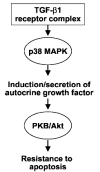Activation of the pro-survival phosphatidylinositol 3-kinase/AKT pathway by transforming growth factor-beta1 in mesenchymal cells is mediated by p38 MAPK-dependent induction of an autocrine growth factor
- PMID: 14576166
- PMCID: PMC1360222
- DOI: 10.1074/jbc.M306248200
Activation of the pro-survival phosphatidylinositol 3-kinase/AKT pathway by transforming growth factor-beta1 in mesenchymal cells is mediated by p38 MAPK-dependent induction of an autocrine growth factor
Abstract
Transforming growth factor-beta1 (TGF-beta1) is a multifunctional cytokine involved in differentiation, growth, and survival of mesenchymal cells while inhibiting growth/survival of most other cell types. The mechanism(s) of pro-survival signaling by TGF-beta1 in mesenchymal cells is unclear. In this report, we demonstrate that TGF-beta1 protects against serum deprivation-induced apoptosis of mesenchymal cells isolated from patients with acute lung injury and of normal human fetal lung fibroblasts (IMR-90). TGF-beta receptor(s)-activated signaling in these cells involves rapid activation of the Smad and p38 MAPK pathways within minutes of TGF-beta1 treatment followed by a more delayed activation of the pro-survival phosphatidylinositol 3-kinase-protein kinase B (PKB)/Akt pathway. Pharmacological inhibition of p38 MAPK with SB203580 or expression of a p38 kinase-deficient mutant protein inhibits TGF-beta1-induced PKB/Akt phosphorylation. Conditioned medium from TGF-beta1-treated cells rapidly induces PKB/Akt activation in an SB203580- and suramin-sensitive manner, suggesting p38 MAPK-dependent production of a secreted growth factor that activates this pro-survival pathway by an autocrine/paracrine mechanism. Inhibition of the phosphatidylinositol 3-kinase-PKB/Akt pathway blocks TGF-beta1-induced resistance to apoptosis. These results demonstrate the activation of a novel TGF-beta1-activated pro-survival/anti-apoptotic signaling pathway in mesenchymal cells/fibroblasts that may explain cell-specific actions of TGF-beta1 and provide mechanistic insights into its pro-fibrotic and tumor-promoting effects.
Figures









Similar articles
-
C-Jun-NH2-terminal kinase mediates expression of connective tissue growth factor induced by transforming growth factor-beta1 in human lung fibroblasts.Am J Respir Cell Mol Biol. 2003 Jun;28(6):754-61. doi: 10.1165/rcmb.4892. Am J Respir Cell Mol Biol. 2003. PMID: 12760970
-
Neuroprotection by transforming growth factor-beta1 involves activation of nuclear factor-kappaB through phosphatidylinositol-3-OH kinase/Akt and mitogen-activated protein kinase-extracellular-signal regulated kinase1,2 signaling pathways.Neuroscience. 2004;123(4):897-906. doi: 10.1016/j.neuroscience.2003.10.037. Neuroscience. 2004. PMID: 14751283
-
Transforming growth factor-beta1 potentiates renal tubular epithelial cell death by a mechanism independent of Smad signaling.J Biol Chem. 2003 Apr 4;278(14):12537-45. doi: 10.1074/jbc.M300777200. Epub 2003 Jan 30. J Biol Chem. 2003. PMID: 12560323
-
[Aberrant Activation Mechanism of TGF-β Signaling in Epithelial-mesenchymal Transition].Yakugaku Zasshi. 2021;141(11):1229-1234. doi: 10.1248/yakushi.21-00143. Yakugaku Zasshi. 2021. PMID: 34719542 Review. Japanese.
-
Mechanism of transforming growth factor-beta1 signaling:Kidney Int Suppl. 2000 Sep;77:S53-8. Kidney Int Suppl. 2000. PMID: 10997691 Review.
Cited by
-
Ionizing radiation induces myofibroblast differentiation via lactate dehydrogenase.Am J Physiol Lung Cell Mol Physiol. 2015 Oct 15;309(8):L879-87. doi: 10.1152/ajplung.00153.2015. Epub 2015 Aug 7. Am J Physiol Lung Cell Mol Physiol. 2015. PMID: 26254422 Free PMC article.
-
The myofibroblast: one function, multiple origins.Am J Pathol. 2007 Jun;170(6):1807-16. doi: 10.2353/ajpath.2007.070112. Am J Pathol. 2007. PMID: 17525249 Free PMC article. Review.
-
Role of fibroblast growth factor 23 and klotho cross talk in idiopathic pulmonary fibrosis.Am J Physiol Lung Cell Mol Physiol. 2019 Jul 1;317(1):L141-L154. doi: 10.1152/ajplung.00246.2018. Epub 2019 May 1. Am J Physiol Lung Cell Mol Physiol. 2019. PMID: 31042083 Free PMC article.
-
Cellular senescence induces replication stress with almost no affect on DNA replication timing.Cell Cycle. 2018;17(13):1667-1681. doi: 10.1080/15384101.2018.1491235. Epub 2018 Aug 21. Cell Cycle. 2018. PMID: 29963964 Free PMC article.
-
NADPH Oxidase Inhibition in Fibrotic Pathologies.Antioxid Redox Signal. 2020 Aug 20;33(6):455-479. doi: 10.1089/ars.2020.8032. Epub 2020 Mar 4. Antioxid Redox Signal. 2020. PMID: 32129665 Free PMC article.
References
-
- Massague J. Nat Rev Mol Cell Biol. 2000;1:169–178. - PubMed
-
- Roberts, A. B., and Derynck, R. (2001) Science’s STKE http:/www.stke.org/cgi/content/full/OC_sigtrans;2001/PE43 - PubMed
-
- Grande JP. Proc Soc Exp Biol Med. 1997;214:27–40. - PubMed
Publication types
MeSH terms
Substances
Grants and funding
LinkOut - more resources
Full Text Sources
Other Literature Sources
Research Materials
Miscellaneous

